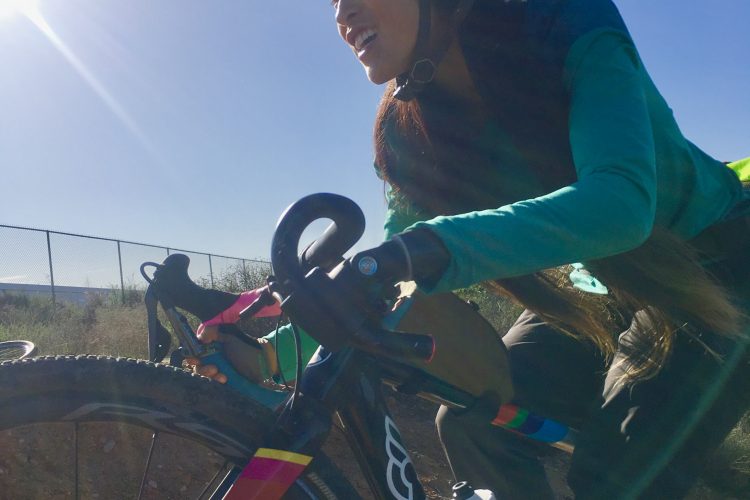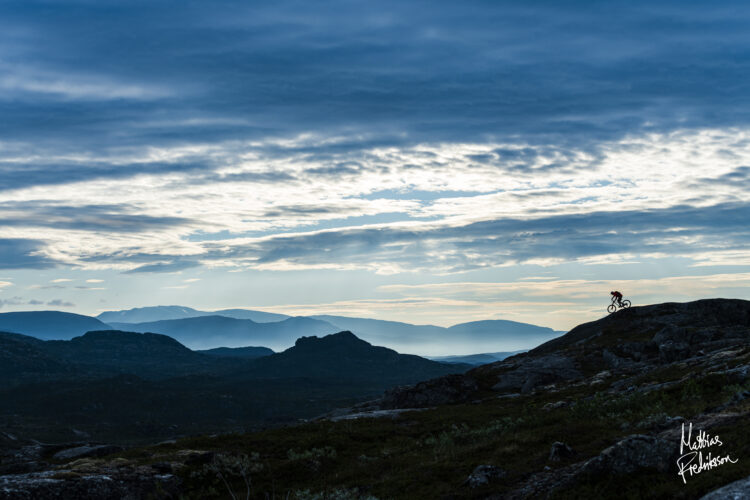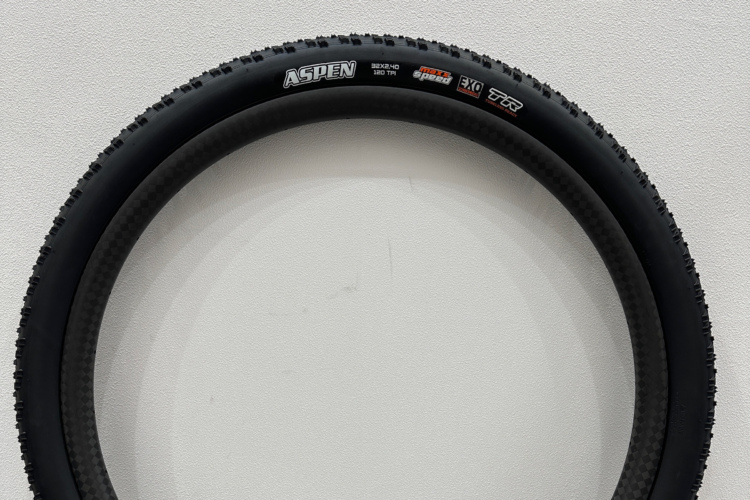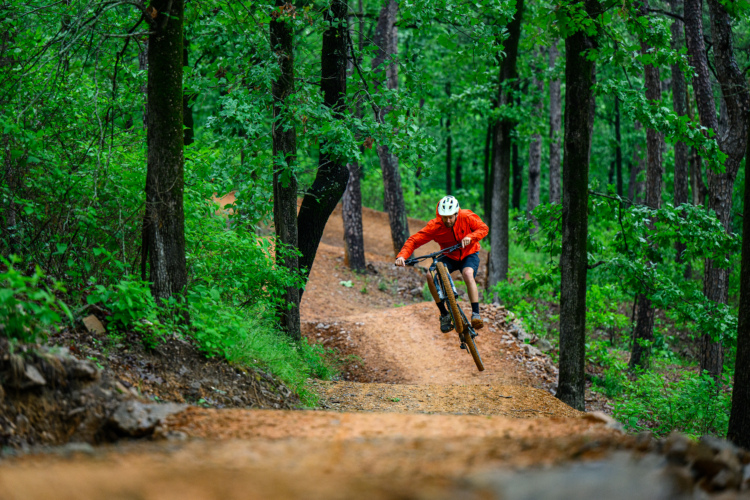
Alongside our ability to clearly and emotively communicate, the second superpower humans have is a profound well of adaptability. We can shift with changes in our environments, diets, and bodies quite well after a reasonable transition period. A few of us even leap ahead of the adaptability curve, making changes in life that our neighbors couldn’t fathom.
Outride ambassador, Blake Steinecke, is one such individual who has a healthy relationship with adversity and change. Six years ago Steinecke was diagnosed with Leber’s Hereditary Optic Neuropathy (LHON), a rare ocular nerve disease that caused him to lose most of his central vision over the course of a year.
Steinecke lives in his hometown of San Marcos, California, just north of sunny San Diego. He has been riding bikes for as long as he can remember, and he started building dirt jumps with friends and spending his entire day riding as soon as the training wheels came off. When Steinecke was in middle school his folks purchased an entry-level mountain bike for his older brother to ride to school and up the local trails. Steinecke wanted to join his sibling on the mountain, so he picked up a hardtail as well, and they set off sliding around in the Southern California forest.
Fond memories came up while we were chatting with Steinecke about those early rides. “We got very hooked on mountain biking. As our other friends were getting more into like dirt jumping and whatnot, we were riding the trails as much as we could and just absolutely destroyed our bikes. I think the best way to learn is to get a cheap hardtail, at least with some disc brakes and just like destroy it.”

The brothers pounded those bikes all the way into Steinecke’s junior year of high school. That’s the year he started to notice some changes in his visual field. “In the beginning of my junior year of high school, I started to notice vision loss in one of my eyes. I didn’t think much of it. I just closed [my eye while] I was reading. I was like, ‘oh shoot it’s just my right eye that looks just ever so slightly blurry.’ I didn’t think anything of it.”
“But I still decided to go the doctor to get checked out, and oh definitely something was wrong. [They said ] the optic nerves seem swollen. I was like, ‘what’s your optic nerve? That doesn’t really sound very good.’ Then over those next couple months, there were tons and tons of tests and needles and scans and everything just to rule out that it wasn’t anything really bad. All the time they told me, ‘yeah, your optic nerve is swollen, but it’s gonna go away and you’ll be fine.’ But the vision kept getting worse. There’s so many different tests. I was getting to a point where I felt like this is gonna be something, but I don’t know what it is.”
The decreasing vision took place in tandem with an increase in Steinecke’s love of mountain biking. “In that time I kept riding and I was looking for a bike for a good deal. I found a 2015 Specialized Enduro on sale because the 2016’s were going to come out. So I remember when my mom and I went to the bike shop, and we bought it, it was like, kind of emotional, because — I wasn’t trying to look at things too morbidly, or negatively, but I was just wasn’t sure what the future of my riding would be. I just wanted to be grateful for where I was at. And there was that push to just really get into it. And it was sweet. I got the bike and then that really excelled my riding and encouraged me to get more and more into it.”
Shortly after purchasing the Enduro, Steinecke entered a local XC race with a friend to get a taste for trail competition, and he had a great time. The event was bittersweet, given that he wasn’t sure how much longer he would be able to enjoy mountain biking. “I remember someone saying ‘oh, you’re gonna have to come back to the next one in June,’ and where my vision loss was going I was like, ‘I don’t know how. I don’t think I’ll be able to do that.’ In that time, during October, of my first semester of my junior year of high school, I was diagnosed with a condition called Leber’s hereditary optic neuropathy. From there, I knew that I would lose all my central vision and become legally blind in both eyes. I was so unsure in that moment of how I could keep riding, how to keep up in school, go to college, work, get married. All of these doubts ran through my head.”
When we spoke it had been roughly six years since Steinecke’s vision became limited enough that he had to drastically alter his way in life. What began as a tiny static blur in one eye grew to consume his entire central visual field in both. He says that his eye can see things fine, but the optic nerve no longer relays all of the information to his brain, and unfortunately the condition cannot be reversed. He provided a simple way to think about his vision for reference. “My vision is at 20/800. So, what you see at 800 feet I see at 20 feet. It’s a super subjective scale, but it’s based off the eye chart. And legally blind, which is just a technical term, is 20/200. I believe that’s kind of the point at which you can’t drive and what not.”
While Steinecke says he didn’t feel depressed as a result of the vision loss, the adjustment period was a struggle in terms of all the tech devices and shortcuts he needed to learn in order to continue with school. For example he had to memorize keyboard shortcuts so he could access things on the computer screen, and quickly picked up the ins and outs of both transcription and read-aloud software. He also had to learn to ask for help, and noted that he had to become far more patient with himself and the newly-navigated world around him.

He would go on to complete high school with top marks, followed shortly thereafter by enrollment in Cal State San Marcos where he completed a marketing degree with a minor in Spanish this past December. College brought a host of new challenges, as Steinecke’s identity shifted amongst his new peers. “College was incredibly brutal, with so many challenges. Stepping into a new place where people don’t know me as my sighted self before. Their only impression is the blind Blake.” He graduated Magna Cum Laude and is now working in the marketing department at nearby TASCO MTB. To check off some of his final fear-box related to vision loss, Steinecke is also happily in love and engaged to be married in the near future.
Out on the trails, Steinecke continues to progress, riding as often as his trail partners can manage. Most of his trail time is spent on the trails near his home, called Double Peak. In place of seeing the best line, he follows a friend with a bell on their bike for a little added direction, and the lead rider calls out drops, rocks, and directions. He can see the bushes alongside the trail somewhat through his peripheral vision, but the direction and sound are the key to his trail success. He can also make out the general shape of the person in front in order to gauge their distance. He can’t however see individual tree branches along the trail until it’s too late, so he wears glasses and goggles to protect his eyes. He says that the ideal situation is to have a lead rider he can follow and a follow rider calling out features, though he often makes it work with one accomplice.
Flat pedals for quick foot-dabs and wide tires for maximum grip help a lot, though Steinecke says that crashing is a regular part of his riding experience. He wears gloves and padding to keep from being badly injured when he goes down.

He says that he wouldn’t necessarily recommend other vision impaired folks try mountain biking unless they were riding prior to losing their sight, but that he does recommend trying to ride bikes in some capacity, to feel the powerful independence that a two wheeled machine can provide. He has had to learn to depend on others in multiple ways over the past six years, and being in control of the bike creates a special kind of freedom for him. As an Outride ambassador, Steinecke travels to area schools to share his story, inspiring young people to push past challenges and work toward their deep hopes and desires.
Before mountain biking took over, Steinecke’s first love was hockey, and he has continued to skate in a league for vision-impaired athletes, even competing on the US national team. He says that the leagues are growing and spreading around the globe as more vision-impaired athletes take to the ice. The rink is divided by sight, and Steinecke says that the players with the largest field of vision playing offense, those with less visual acuity play defense, and goalies are completely blind.

Before hopping off the phone Steinecke spoke of the pivotal moment when he realized that he would still be able to ride his bike. His family was planning a vacation in British Columbia, where his mother was born, and he asked that they take a little detour to Whistler Bike park. He contacted Whistler Adaptive Sports to ask if someone would be available to guide him, and though they had only done so with skiers the team was happy to try it out. In the weeks leading up to the trip Steinecke experienced a great deal of doubt about being able to ride trails he didn’t know in the world-class bike park. His friend Ryan, who worked for Bike Mag at the time, encouraged him to go for it, and shared stories all about the amazing trails in Whistler. Steinecke went, and he says that after sessioning the Crank it Up track over and over with guides he realized that he could ride and even progress on the bike with his new vision.











2 Comments
Jun 7, 2021
Matt Gilman has been going at it for some years now, blind and showing the sighted how it is done.
Blind Bike Trials - YouTube
Jun 3, 2021
Though if he can see some in the periphery vision, could some sort of camera with augmented reality help out by shining an on the fly topo map/gps position in to the side of his eye?